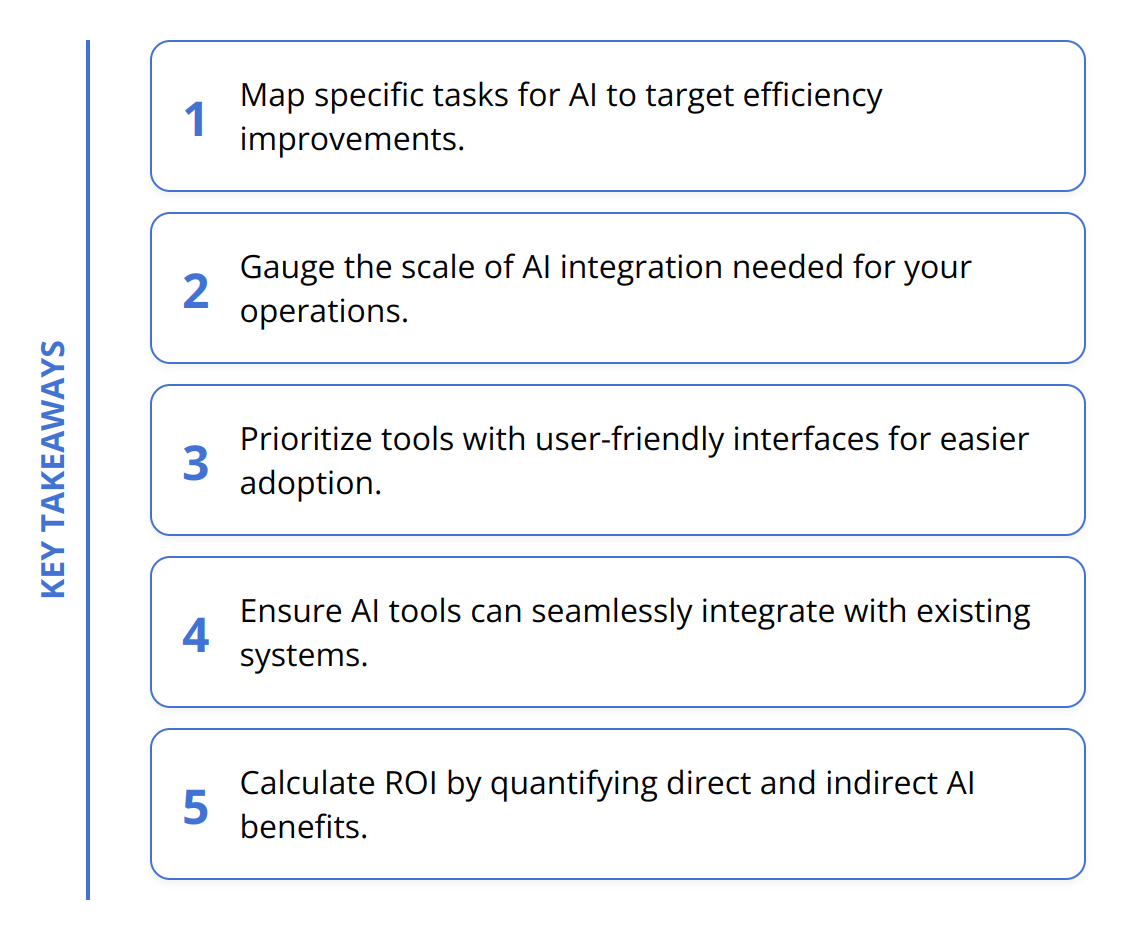Selecting the right AI tool can be a game-changer for your business. It’s about matching technology with your specific needs to drive efficiency and growth. We at Emplibot understand that the landscape is vast and the options numerous, making the decision process complex. This post aims to simplify that process, guiding you through understanding your requirements, evaluating AI tools, and conducting a cost-benefit analysis.
Contents
TogglePinpointing Business Needs
When it comes to integrating AI into your business operations, a razor-sharp understanding of your specific needs is essential. Every business is a unique entity; what works for one may not work for another. Let’s tackle how to precisely identify what your business demands from AI technology.
Firstly, mapping out the specific tasks you aim to automate or enhance with AI is crucial. Start by auditing your current processes and pinpoint areas where efficiency could be significantly improved. This might range from automating routine administrative tasks to implementing sophisticated AI-driven analytics for data-driven decision-making. The goal here is to identify tasks where AI can bring the most value, not just where it can be used.
Understanding the scale of AI integration you’re aiming for follows. This isn’t merely about the number of tools but the depth of their implementation across your operations. For small businesses, this might involve adopting a single AI tool that addresses a core need, such as enhancing customer service through an AI chat interface. Larger organizations might look towards a suite of AI tools for a more comprehensive transformation covering marketing, sales, HR, and more. Accurately gauging this scale will guide your selection process, ensuring you don’t overinvest in technology that surpasses your requirements or underutilize AI’s potential.
Usability and accessibility of the AI tools cannot be overstated. The most powerful AI technology loses its value if it’s not user-friendly or accessible to your team. This includes considering the learning curve associated with new tools, the technical support offered, and how well the tool integrates with your existing tech stack. Tools that require minimal coding knowledge or offer intuitive drag-and-drop interfaces can significantly lower the barrier to entry, making AI accessible to a broader range of businesses.

.
Incorporating AI into your business effectively boils down to a precise match between your unique needs and the capabilities of AI tools. This requires thoughtful consideration and planning but leads to transformative efficiency and growth opportunities when done correctly.
For more insights on evaluating AI tools based on their features, you might find our article on AI for branding helpful. It provides a closer look at selecting AI technologies that align with specific business functions, a principle that applies across various areas of AI adoption.
Evaluating AI Tools
Once you’ve identified what your business needs from artificial intelligence (AI), the next step is evaluating the wide array of tools at your disposal. This phase is about focusing on the specifics of what each tool offers and ensuring it aligns with your objectives.
Machine Learning and Automation Capabilities
The essence of an AI tool lies in its machine learning and automation capabilities. Not all AI is created equal; some tools are built for specific tasks, while others offer more broad applications. For instance, a tool might excel at analyzing large data sets to provide insights (machine learning), or it might be geared towards automating repetitive tasks (automation). Defining your needs will help narrow down the search. Look for tools that not only process data efficiently but also learn from it to optimize future tasks.
Seamless Integration is Key
A tool that cannot be easily integrated into your current systems might cause more headaches than it’s worth. The goal of implementing AI is to streamline operations, not complicate them. When evaluating tools, pay close attention to compatibility with your existing software. This might include seamless data transfer capabilities, the ability to plug into your CRM, or compatibility with your marketing platforms. An AI tool that enhances your existing setup without extensive modifications is ideal.
User Support and Community Engagement
The quality of user support and the presence of an active community around an AI tool can make a significant difference, especially in troubleshooting and innovation. Direct support from the tool’s developers can help solve specific problems, while a vibrant community can offer quick hacks and tips based on real-user experiences. Tools that offer comprehensive guides, tutorials, and responsive customer support should rank higher on your list. This support infrastructure is invaluable, as it helps ensure your journey integrating AI into your business is as smooth as possible.

For insight into tools that enhance content creation and the user experience, exploring our resources on AI content creation might provide valuable direction. Similarly, businesses aiming to leverage AI for market research may benefit from understanding advanced techniques available.
In conclusion, evaluating AI tools requires a detailed examination of their machine learning and automation features, integration capabilities, and the level of user support available. Making an informed choice ensures that the AI tool you select not only fits your immediate needs but also scales with your business growth.
Analyzing Cost and ROI
When integrating AI into your business, understanding the financial implications is as vital as recognizing its operational benefits. This involves not just looking at the price tag but delving deeper into the initial investment, the ongoing costs, and the expected return on investment (ROI). By doing so, businesses can make informed decisions that align not only with their technological needs but also with their financial realities.
Initial Investment vs. Long-term Benefits
The initial cost of AI tools can vary widely, from affordable solutions suitable for small businesses to more comprehensive systems designed for large enterprises. This initial investment is not just about purchasing the software but also includes the cost of integration, training, and any necessary hardware upgrades. However, the focus should be on the long-term value these tools bring. AI-driven improvements in efficiency, productivity, and customer satisfaction can far outweigh initial costs, leading to significant financial benefits over time. Companies that view AI tools as an investment rather than an expense are more likely to reap the rewards of advanced technology.
Hidden Costs: Maintenance and Upgrades
One area that businesses often overlook is the ongoing cost associated with maintaining and upgrading AI systems. Unlike standard software that might require occasional updates, AI tools evolve rapidly, with new features and capabilities constantly emerging. This means businesses must budget for regular updates and possibly additional training for staff to keep up with new functionalities. Additionally, depending on the AI tool’s complexity, there might be maintenance fees or costs related to cloud storage or computing power required to run the AI smoothly. Anticipating these costs ensures they don’t become unwelcome surprises down the line.
Calculating Return on Investment for AI Tools
To truly understand the value of your AI investment, calculating the ROI is essential. This involves quantifying the benefits—such as reduced labor costs, increased sales from improved customer targeting, and efficiency gains—and comparing them to the total cost of ownership of the AI solution. While some benefits, like improved customer satisfaction, may be harder to quantify, focusing on measurable outcomes provides a clearer picture of the tool’s impact. A positive ROI indicates that the AI tool is not just a valuable addition to your business but also a wise financial decision.

.
For practical guidance on integrating AI with your marketing strategy, our resource on AI marketing tips could offer valuable insights.
-
Understand the full scope of the initial investment beyond the purchase price.
-
Factor in ongoing costs for maintenance and upgrades in your budget.
-
Quantify both direct and indirect benefits when calculating ROI.
Taking a holistic view of both costs and benefits of AI tools enables businesses to navigate the financial aspects of AI adoption effectively. This approach ensures that your investment in AI technology aligns with both your operational goals and your financial constraints, positioning your business for sustained growth and success in the digital age.
Wrapping Up
In the journey to embrace AI technology for your business, pinpointing specific operational needs, meticulously evaluating prospective AI tools, and thoroughly analyzing financial implications stand as foundational steps. These considerations assure that the AI tools not only blend seamlessly with your business operations but also propel growth and efficiency, transcending mere technological integration.

A pivotal aspect that businesses need to emphasize is continuous learning and adaptation. The AI landscape is ever-evolving, with advancements and updates becoming the norm. Staying abreast of these developments ensures your AI integration remains competitive and effective. Encountering challenges during implementation is part of the journey. Leverage these experiences to refine your approach and enhance your competency in utilizing AI tools.
Moreover, adopting a forward-thinking mindset proves instrumental. AI is not just about resolving today’s problems but about anticipating future trends and preparing your business to meet them head-on. This approach fosters an environment of innovation, where leveraging AI becomes a strategic advantage rather than a mere operational tool.
We at Emplibot are dedicated to making AI technology accessible and productive for your business. Our platform simplifies the creation of SEO-friendly articles for your WordPress site, embodying the principles of efficiency and growth propelled by AI. By automating content creation, including keyword research, image selection, and internal linking, we enable businesses to maintain a vibrant, SEO-optimized blog effortlessly. Discover more about how Emplibot can revolutionize your content strategy on our website.
In summary, selecting the right AI tool is a strategic decision that requires careful consideration, an eagerness to learn, and a vision for the future. By approaching AI with a deliberate and informed mindset, businesses can unlock the potential to drive significant value and stay ahead in the digital landscape.











